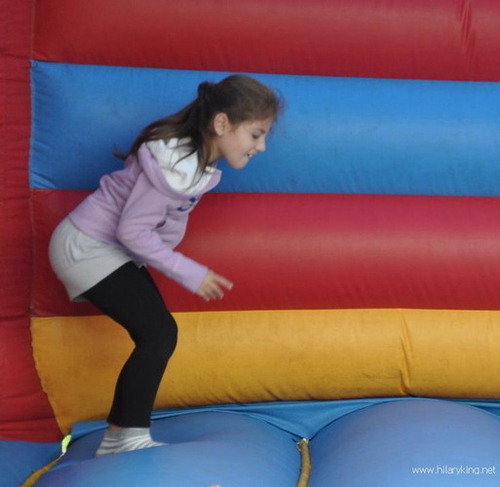‘Monkey Position’ is the nickname for the Position of Mechanical Advantage as F M Alexander called it, and refers to the position that is ideal to utilize when bending forwards whilst standing. To use this position, we hinge and fold forwards at the hip joints with the knees bent and the ankles freely folding so that the knees can direct out over the toes. The movement is made whilst maintaining the length in the spine – without arching the lower back, curling over, or shortening the neck by pulling the head back and down. It’s a really useful movement to use when chopping the veg or putting on your shoes!
It is unfortunate that this has been called a ‘position’ as this makes it seem a static way of holding the body, rather than allowing the body to move naturally, as in sitting down and standing up – or landing from a jump, when our legs act like springy shock absorbers.

Child naturally using ‘monkey position’ as she lands from a jump.
The monkey position is a very basic and natural movement seen in most small children but it often gets lost as a way of moving by the time we become adults. However, it is used by many sportsmen such as cricketers and golfers, plus people who carry heavy loads and need to look after their backs. Of course it is also used by our close relations, the monkeys.
Racism?
Sadly, a number of people find the use of the term ‘monkey position’ repellent, as it is too similar to some racist taunts that have been used. This is unfortunate but as yet, we have not established another casual term for the position of mechanical advantage. It is fair to say that the term has traditionally had positive connotations in the Alexander world and is not used in a derogatory manner.
Protect your back
This way of bending forwards protects the back, whereas the common pattern of misuse that many people fall into – crumpling forwards and pulling the head back – compresses the spine and creates back strain, particularly if a heavy object is being picked up. In many cases, this unhelpful way of moving can contribute to disc prolapse and problems such as sciatica. You can also read how using the body in this way can be particularly useful to use during pregnancy, childbirth and after.
Patrick Macdonald (in his book which is aimed at Alexander teachers) sites the case of Finnish lumber men in the arctic circle who found ‘that in their daily work, which was very hard, it was essential to keep a straight back and use their joints (the Monkey position) if their backs were not to break down under the strain’ p 21
Patrick Macdonald ~ The Alexander Technique as I See It
The Monkey Position Procedure
This is taught in Alexander lessons and is a stylized version of this natural movement and is used to help pupils find, or regain, and explore the hinging movement in their hip joints, allowing the spine to retain its length as they hinge forwards. Once learned, pupils can then use this way of moving to look after their backs in everyday life activities. For instance, when performing actions which require a deep monkey position, such as picking an object up off the floor and those that only require a small version of monkey, such as washing the dishes.
A small monkey position is also very useful to use when coughing and sneezing, so that the somewhat violent spasms produced, are less likely to damage the back – osteopaths gain a number of new patients each year, who have hurt their backs this way. Remember – Bend your knees when you cough and sneeze!
The same principle may be applied to squatting or bending forwards whilst sitting. So we can fold our bodies forwards whilst hinging in the hips, knees and ankle joints and maintaining the length of the spine, in order to perform actions such as moving a chair, riding a bike or playing the guitar.
We can also modify monkey position so that we can use lunging movements when active and playing tennis or sweeping floors, for instance. In this way, we use the strong, major structure of the hip joints and protect the smaller and more vulnerable bones and discs in the spine, as we bend and move around.
Squat
The position of mechanical advantage is similar to a squat but the main difference is the way the movement is performed. In Alexander lessons, the position of mechanical advantage is incorporated into our everyday movements. Squats however, are used as a repetitive strength exercise, or held, as in a static squat. Of course, the AT approach to this movement can be applied to performing squats, so they can be done with more awareness and an avoidance of end-gaining. This process is explored in depth in ‘Master the Art of Working Out‘.